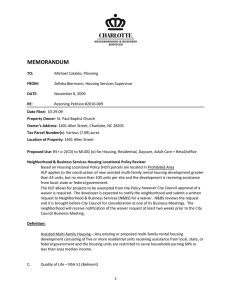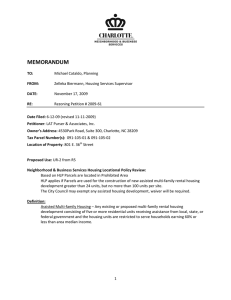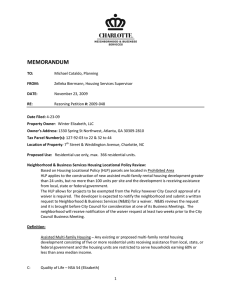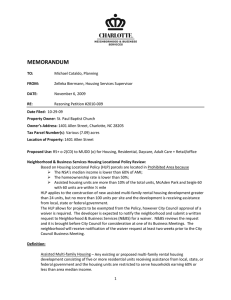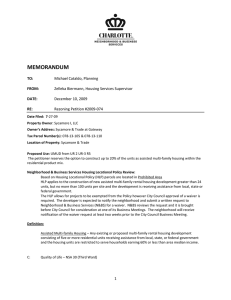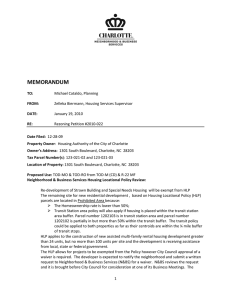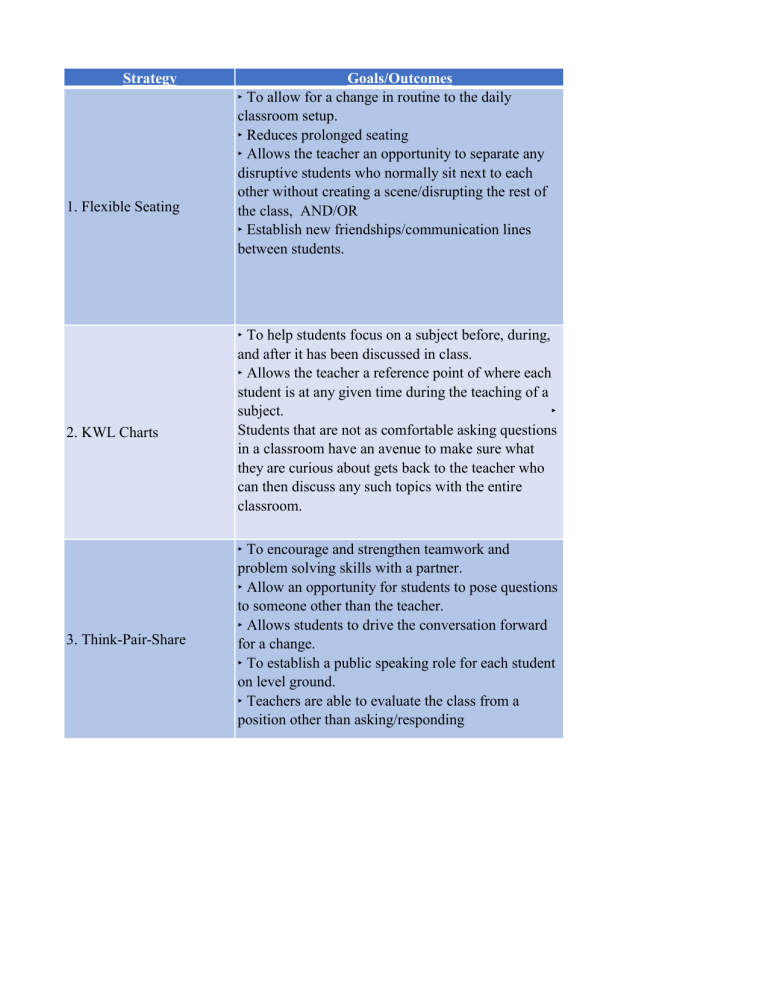
Strategy 1. Flexible Seating 2. KWL Charts 3. Think-Pair-Share Goals/Outcomes ‣ To allow for a change in routine to the daily classroom setup. ‣ Reduces prolonged seating ‣ Allows the teacher an opportunity to separate any disruptive students who normally sit next to each other without creating a scene/disrupting the rest of the class, AND/OR ‣ Establish new friendships/communication lines between students. ‣ To help students focus on a subject before, during, and after it has been discussed in class. ‣ Allows the teacher a reference point of where each student is at any given time during the teaching of a subject. ‣ Students that are not as comfortable asking questions in a classroom have an avenue to make sure what they are curious about gets back to the teacher who can then discuss any such topics with the entire classroom. ‣ To encourage and strengthen teamwork and problem solving skills with a partner. ‣ Allow an opportunity for students to pose questions to someone other than the teacher. ‣ Allows students to drive the conversation forward for a change. ‣ To establish a public speaking role for each student on level ground. ‣ Teachers are able to evaluate the class from a position other than asking/responding 4. Exit Cards ‣ Avenue for students to provide helpful feedback to teachers about what they have taken away from their time in class. ‣ Allows for consistent communication between teachers and students who are less comfortable speaking in class. ‣ Provides a short period of social time at the end of class that is still aimed towards class activities ‣ Can be used to better relate to students through asking about what they have planned for their evenings/what their weekends were like. ‣ Invites students to learn more about places other than their own city/country. ‣ Allow students the opportunity to work with and understand real-world situations involving distance, time, currency, and mapping. ‣ Students are able to share real-life experiences about places they have visited or even lived. 5. Traveller 6. Turn and Talk ‣ Effective way to take a break or change pace in the middle of a lesson. ‣ Promotes peer-to-peer discussion about learning. ‣ May result in a better understanding when discussed with a peer from a different perspective than what the teacher is presenting. ‣ Students that have an understanding of the content are able to speak confidently about it further enhancing their grasp. ‣ As opposed to the teacher answering a finite number of questions from students during a lesson, each student now has an opportunity to air their confusion or queries about what is being discussed. ‣ Quick and effective, requires minimal disturbance to the flow of class. 7. Brain Dump 8. LAR (Learn, Apply, Reflect) ‣ Used to help the teacher evaluate where a student or the entire class is at in its learning of a subject/lesson. ‣ Emphasises retrieval as an effective learning strategy for students moving forward ‣ Helps weed out incorrect associations students may have about the content covered in class. ‣ Speed factor provides this activity with a game-like element that could translate to prizes or benefits to students who make the most correct associations. ‣ To gauge or reinforce students' understanding of a term/concept by having them apply it to situations they are interested in. ‣ Can be applied to a variety of subjects. ‣ Allowing students to choose how they want to apply the concept as a way of rewarding good in-class behaviour, but can be assigned by teacher if there is a lack of focus or understanding. ‣ Not limited to the classroom in terms of where/when this strategy can be utilized, possibly freeing up more time for other activities in-class. ‣ Takes students' minds outside of the confinements of the classroom to think about why what their learning is practical. ‣ Having students choose how or where to make the transfer may give the teacher better insight to their students' interests. 9. Group Peer Quiz 10. Chain Notes 11. Walk and Talk ‣ To have students create and answer quizzes made by their peers. ‣ Reinforce team-work and communication within groups. ‣ Provide feedback on where the class is at in its overall understanding of a lesson. ‣ Gives responsibility/power to the students in that they decide what the content is and then grade the quiz before presenting to the class. ‣ Provides various perspectives/ideas to students from their peers as opposed to the same perspective of the teacher to all the students. ‣ Help keep active lines of communication open between teacher and students. ‣ Teachers can gauge whether or not there is common understanding within the classroom or if the lesson needs to be approached from a different perspective. ‣ Can be used to submit anonymous questions or comments to the teacher regarding content that is confusing or sensitive. ‣ Conflicting questions/perspectives could be placed on two envelopes to fuel further conversation about learned content. ‣ Have students engage in class-relevant conversation while being active at the same time. ‣ Can promote peer bonding. ‣ Breaks up long periods of seating. ‣ Promotes being active. ‣ Can be a memorable portion of the students day and therefore make a lasting connotation with the subject discussed. 12. Four Corners 13. Letters Through Time 14. Literature Circles ‣ A fun and active way of separating the classroom for the purposes of answering questions, forming groups, while evaluating or learning more about your students. ‣ Breaks up long periods of seating. ‣ Effective ice-breaker activity for the beginning of the year to establish a base-understanding of where various students are at. ‣ Promotes on-the-fly thinking as students move and think quickly to answer questions by getting into position. ‣ Can establish new relationships between students as similarities in interests are discovered through their answers to certain questions. ‣ Effective formative assessment strategy to evaluate students' knowledge of history lessons as well as the actions of historical figures. ‣ Students are able to work both individually (in drafting their letters) as well as with a partner (discussing the context of their setting). ‣ Encourages peer-to-peer discussion relevant to inclass readings. ‣ Assists students who may not retain as much through readings alone or that struggle with reading in general. ‣ Can start as one large circle at the beginning of the year and break into smaller groups as lessons progress. This allows for the teacher to establish what's expected within these circles early and then hand over responsibility to the students over time. ‣ Promotes communication and public-speaking. ‣ Potential for leadership qualities to emerge within students willing to lead and expand discussions. ‣ Allows the teacher to move from circle to circle and add points or ideas from other circles. ‣ An attempt to better connect one-on-one with each student to make sure they are able to take away as much as possible from a teacher. ‣ Class-long lectures are replaced as slide-shows or videos to be completed as homework as opposed to being done in-class. ‣ While this may not be practical for classes with a 15. Personalized Learning high volume of students, it can be more effective than spending the bulk of class-time addressing everyone as though they're on level ground, educationally. ‣ Allows for teachers to get to know their students on a much more personal level, utilizing their likes, hobbies, dislikes to the teachers advantage in lessons. 16. Pro and Con Grid 17. Reciprocal Teaching ‣ To challenge critical thinking in students and not have them take the lesson at face value. ‣ Generate new perspectives on what the lesson taught various students. ‣ Have students consider other ways of understanding the content based on answers their peers come up with. ‣ Turning reading assignments into more by having students complete a series of tasks before, during, and after the reading takes place. ‣ Reinforces co-operation as groups work together to complete tasks. ‣ Can remove stress involved with students that may be weaker readers as they can reflect within a group about ideas. ‣ Class readings won't be held up by individual slow readers who can be grouped with stronger readers to lean on. 18. News Analysis 19. Jigsaw ‣ A interdisciplinary approach to generate conversation, use critical thinking, and apply lessons learned in class to tackle new challenges. ‣ Showcases how lessons learned in-class can be applied in real-world scenarios. ‣ Students become aware of various initiatives within their community, can be especially impactful for those that may be new to the school/town. ‣ After assignment presentations allow for peer-topeer questions and feedback. ‣ Providing students the opportunity to research a specific aspect of a lesson, familiarize themselves with that aspect, then teach that aspect to their classmates. ‣ Simultaneously exercises team-work, leadership, and speaking skills for each student. ‣ Each student is given the responsibility of teaching their classmates, changing up the usual teacher-led lessons. 20. CRT (Culturally Responsive Teaching) ‣ An effort to make all students comfortable in the classroom based on their unique culture/backgrounds. ‣ Ensuring students that do not speak the same language or that struggle to relate to in-class scenarios still have an avenue to connect to the learning. ‣ Provides an opportunity for teachers to have a better relationship with their students. ‣ Fellow students are exposed to learning about other peoples cultures, beliefs, or backgrounds. ‣ Over time, other students may walk away with a better knowledge of the lesson material by associating it with these experiences. In-Class Application ‣ Randomly select days of the week/month where the normal row of desks and chairs is replaced by outside-the-box arrangements. ‣ Examples can include radical changes such as bringing in bean-bag chairs or exercise balls for students to sit on or can be as simple as rearranging the chair or desk layout. ‣ This can be applied to the entire class as a whole or can be done in groups/stations where students can move around, i.e. from chairs> bean bags> balls. HLP Association ‣ HLP 1: Leading a group discussion. ‣ HLP 5: Implementing norms and routines for classroom discourse and work. ‣ HLP 9: Setting up and managing small work groups. ‣ Charts can be pre-made by teachers or blank sheets can be handed out to allow for the students to create their own chart, unique in style to them. ‣ Students then fill out the first two rows prior to a lesson (K - What I Know About this Subject and W What I Want to Learn About this Subject) ‣ Upon completion of the lesson, have the students fill in the final row (L - What I Learned About this Subject) and review rows K and W. ‣ HLP 6: Coordinating and adjusting instruction during a lesson. ‣ HLP 13: Setting long- and short-term learning goals for students. ‣ Pose a question to the classroom or allow them to choose from a pre-determined list of subjects/scenarios. ‣ Assign or allow students to pick (reward for positive classroom behaviour) partners to discuss and/or come up with a solution. ‣ Have the pairs deliver their answer/solution in front of the rest of the class, allowing opportunity for questions and feedback from peers as well as the teacher. ‣ HLP 1: Leading a group discussion. ‣ HLP 7: Specifying and reinforcing productive student behaviour. ‣ HLP 15: Checking student understanding during and at the conclusion of lessons. ‣ HLP 18: Providing oral and written feedback to students. ‣ Just prior to the end of class, have students respond to a few questions posted on the board such as "What was your favourite part of class today?" or "What 3 things did we discuss/learn about today?". ‣ Teachers can choose to utilize a standardized sheet with the same questions, handed out each class or the use of a journal if the questions vary from class-to-class. ‣ Students can work alone or in small groups to discuss the days activities and can only leave after submitting their responses. ‣ HLP 5: Implementing norms and routines for classroom discourse and work. ‣ HLP 10: Building respectful relationships with students. ‣ HLP 15: Checking student understanding during and at the conclusion of lessons. ‣ HLP 17. Interpreting the results of student work, including routine assignments, quizzes, tests, projects, and standardized assessments. ‣ Best suited for geography or history courses, students design a dream (or recently taken) vacation. ‣ Option to have students select a destination of interest prior to beginning of the lesson and let them research and apply what they learn as they go. ‣ Drawing off of content covered in class, students go into detail about highlights of their vacation. ‣ Students discuss historical events or landmarks that exist in their country/ies. ‣ Content such as language, currency, weather can be incorporated, depending on what is best suited to the content learned in class. ‣ HLP 7: Specifying and reinforcing positive student behaviour. ‣ HLP 12: Learning about students' cultural, religious, family, intellectual, and personal experiences and resources for use in instruction. ‣ HLP 13: Setting long- and short-term learning goals for students. ‣ During a lesson teacher tells students to turn to the person beside/behind them to discuss the content of the current lesson. ‣ Students can provide clarity to those that are unsure, ponder further applications of the lesson, or work together to generate feedback for the teacher. ‣ Turn and Talk can be something that is pre-determined to take place during the lesson by the teacher or inserted on-the-fly if there is a sense of confusion or that some students have gotten lost along the way. ‣ Once finished, the classroom can provide more concentrated feedback/questions to the teacher in the interest of moving the lesson forward from this point. ‣ HLP 1: Leading a group discussion. ‣ HLP 6: Coordinating and adjusting instruction during a lesson. ‣ HLP 15: Checking student understanding during and at the conclusion of lessons. ‣ A Brain Dump can be done at an individual, group, or classroom level. ‣ More effective when done multiple times throughout the learning of a lesson (start, middle, end for example). ‣ Teachers will pose a term/idea that was or will be discussed in the class and the students record everything they know, or think, associates with that idea. ‣ Common answers can be recorded quickly and removed from conversation to focus more on less-common suggestions. ‣ HLP 1: Leading a group discussion. ‣ HLP 3: Eliciting and interpreting individual students' thinking. ‣ HLP 4: Diagnosing particular common patterns of student thinking and development in a subject-matter domain. ‣ HLP 15: Checking student understanding during and at the conclusion of lessons. ‣ Once a lesson has completed have students make connections to real-world situations and report back on how and what they have learned. ‣ Can be done in-class or as a take-home assignment. ‣ Examples could include: For mathematics, having students determine the height of their house or a tree after a trigonometry lesson. For English, having students identify parts of movies or video games, of their choosing, such as the climax or which characters are the protagonists. ‣ HLP 2: Explaining and modeling content, practices, and strategies. ‣ HLP 3: Eliciting and interpreting individual students' thinking. ‣ HLP 7: Specifying and reinforcing productive student behaviour. ‣ HLP 10: Building respectful relationships with students. ‣ HLP 15: Checking student understanding during and at the conclusion of lessons. ‣ Break the classroom into an even number of small groups. ‣ Each group will create a quiz (i.e. 5 questions) focused around an on-going or recently completed lesson. ‣ Questions can be thought of by the students, selected from a larger, pre-determined list provided by the teacher, or a hybrid of both. ‣ After the quizzes have been exchanged between groups and completed, exchange completed quizzes with a third group for marking. ‣ Once marked, return quizzes to original group and have each group explain what was asked, answered, and debate why it was right or wrong. ‣ HLP 1: Leading a group discussion. ‣ HLP 8: Implementing organizational routines. ‣ HLP 9: Setting up and managing small group work. ‣ HLP 14: Designing single lessons and sequences of lessons. ‣ HLP 15: Checking student understanding during and at the conclusion of lessons. ‣ The teacher poses a question to the class and writes it on an envelope then passes it around the class. ‣ Students write down their response, put it in the envelope and pass it to the next student. ‣ When the envelope has been returned to the teacher answers can be pulled out and discussed/debated by the whole classroom. ‣ HLP 1: Leading a group discussion. ‣ HLP 4: Diagnosing particular common patterns of student thinking and development in a subject-matter domain. ‣ HLP 15: Checking student understanding during and at the conclusion of lessons. ‣ HLP 18: Providing oral and written feedback to students. ‣ Pose a question/thought/topic to the classroom and have them pair up. ‣ Depending on circumstances related to the school environment, get the students into an area where they are free to walk around (i.e. gym, playground, hallways). ‣ Pairs then debate/find a solution to the problem delivered in-class, where they can return and discuss. ‣ Once again depending on circumstances, final class discussion could take place gathered in the playground/gym to provide a unique end to the activity. ‣ HLP 1: Leading a group discussion. ‣ HLP 5: Implementing norms and routines for classroom discourse and work. ‣ Label the four corners of the room, i.e. A, B, C, and D. ‣ Conduct a multiple choice test wherein the students answer by moving to the corresponding corner of the room with their answer. ‣ Can also be an effective way to break the classroom into groups. ‣ Replace the A, B, C, D format with pictures as answers to learn more about your students while still breaking into groups (i.e. which ice cream flavour is your favourite? Then have photos of various flavours). This can be expanded beyond the 4 answers to establish numerous, smaller groups. ‣ HLP 3: Eliciting and interpreting individual students' thinking. ‣ HLP 4: Diagnosing particular common patterns of student thinking and development in a subject-matter domain. ‣ HLP 9: Setting up and managing small group work. ‣ HLP 10: Building respectful relationships with students. ‣ HLP 15: Checking student understanding during and at the conclusion of lessons. ‣ Students are divided into pairs and given a scenario, typically historical but could also be applied in political or English based lessons. ‣ Partners then send letters back and forth to each other demonstrating their knowledge of the period of time or specific backdrop of their scenario. ‣ Attaching students to the perspective of a realworld figure can add another layer to the information available. ‣ HLP 3: Eliciting and interpreting individual students' thinking. ‣ HLP 9: Setting up and organizing small group work. ‣ HLP 14: Designing single lessons and sequences of lessons. ‣ During or following a text-based lesson, students arrange themselves in a circle, either as a class or in groups, to breakdown the content of the readings. ‣ The teacher is encouraged to move within the classroom to sit in or simply observe the circles as they discuss ‣ Teachers should look to push the conversation in certain directions as they see fit. ‣ HLP 1: Leading a group discussion. ‣ HLP 8: Implementing organizational routines. ‣ HLP 9: Setting up and managing small group work. ‣ Normal class structure of teacher speaking to the room is replaced by increments of personalized time with each student. ‣ Lesson lectures are swapped with assignments as homework, where students take-in the content via a slideshow or video. ‣ Typical "homework" assignments are completed in-class where teachers have the opportunity to address questions as they arise instead of grading them as homework the next day. ‣ HLP 2: Explaining and modeling content, practices, and strategies. ‣ HLP 3: Eliciting and interpreting individual students' thinking. ‣ HLP 7: Specifying and reinforcing productive student behaviour. ‣ HLP 10: Building respectful relationships with students. ‣ HLP 12: Learning about students' cultural, religious, family, intellectual, and personal experiences and resources for use in instruction. ‣ HLP 18: Providing oral and written feedback for students. ‣ At the end of a lesson have students arrange a list of pros and cons (maybe 10 each, for example) based on an open-ended concept that was discussed. ‣ Done individually or in a group setting. ‣ Review the various lists when complete and make connections between similar or conflicting opinions as to what is or is not a pro/con. ‣ HLP 1: Leading a group discussion. ‣ HLP 4: Diagnosing particular common patterns of student thinking and development in a subject-matter domain. ‣ HLP 15: Checking student understanding during and at the conclusion of lessons. ‣ Divide students up into groups and assign roles based on what information you are looking to get from each group (i.e. having one student in a group summarize the readings or identifying key terms). ‣ As a group, students then read the assigned passage, this can be done silently or taking turns out loud depending on the make-up of the class. ‣ While completing the readings students can make connections or take notes based on what it is their role dictates they are doing. ‣ Groups present their findings at the end and the class can engage in discussion about their different findings. ‣ Roles can be recorded and swapped for future usage, ensuring students can experience different objectives within their readings. ‣ HLP 4: Diagnosing particular common patterns of student thinking and development in a subject-matter domain. ‣ HLP 8: Implementing organizational routines. ‣ HLP 9: Setting up and managing small group work. ‣ Teacher brings in newspapers or shows a specific news clip to the class and then posses questions based around the content. ‣ Students can break into pairs or groups to come up with solutions to the questions. ‣ If the potential exists for different groups to pick their news article, this would provide an opportunity for various presentations at the end of the assignment. ‣ Examples could include: An article discussing building a new park in the community. Tying this in with a science class, where is the best place to place the new park? What kinds of ecosystems would exist? Is there a prominent water source, if not, can one be developed? ‣ HLP 9: Setting up and managing small group work. ‣ HLP 14: Designing single lessons and sequences of lessons. ‣ HLP 17: Interpreting the results of student work, including routine assignments, quizzes, tests, projects, and standardized assessments. ‣ Students are assigned a fragment (x) of a subject following a reading or completion of a lesson. ‣ The class is then divided into four "home" groups, comprised of students with various fragments (x, y, z). ‣ Once familiar with their home groups, students then breakaway into a second "expert" group with students who share the same assigned fragment (x). ‣ Discussing with their expert groups, students can formulate a better understanding of their fragment. ‣ Finally, students return to their home groups to teach/explain their fragment and its applications to the rest of their group. ‣ HLP 1: Leading a group discussion. ‣ HLP 4: Diagnosing particular common patterns of student thinking and development in a subject-matter domain. ‣ HLP 6: Coordinating and adjusting instruction during a lesson. ‣ HLP 9: Setting up and managing small group work. ‣ Teachers must do their best to establish a baselevel understanding of any cultural differences that may exist within the classrooms. ‣ When identified, make a conscious effort to incorporate imagery or phrases that may be familiar to students' unique backgrounds. ‣If they are comfortable, invite students to talk about their cultures/beliefs during a lesson. Teach the class a new word that mirrors one being discussed in-class, or have them provide scenarios that may better relate to their experiences. ‣ HLP 1: Leading a group discussion. ‣ HLP 10: Building respectful relationships with students. ‣ HLP 12: Learning about students' cultural, religious, family, intellectual, and personal experiences and resources for use in instruction. Drawn From ‣ https://www.prodigygame.com/mainen/blog/flexible-seating-classroom-ideas/ ‣ https://www.facinghistory.org/resource- library/teaching-strategies/k-w-l-charts ‣ ‣ https://teaching.utoronto.ca/teachingsupport/active-learning-pedagogies/activelearning-adapting-techniques/think-pairshare/ ‣ https://sites.up.edu/tl/exit-cards-a-simpleformative-assessment-strategy/ ‣ Expanded upon off of concept found in link below. ‣https://www.educationworld.com/a_tech/t echlp/techlp028.shtml ‣https://www.rbteach.com/sites/default/files /turn_and_talk-west_and_cameron.pdf ‣ https://ditchthattextbook.com/stickylearning-digital-brain-dumps-with-flipgridand-socrative/ ‣ Concept utilized in my Grade 11 math class that I have expanded on to apply to other subjects. ‣ Expanded upon from commonly found peer-to-peer quizzes that were popular during my elementary school years. ‣https://app.secure.griffith.edu.au/exlnt/entr y/8669/view ‣https://www.responsiveclassroom.org/sites /default/files/pdf_files/EYM_walk_talk.pdf ‣ Demonstrated by Professor with entire class in my B.Ed. Aboriginal Education course. ‣ Experienced as a paper that was assigned to me, though as an individual assignment, in my Russian History course at Lakehead. ‣https://www.education.vic.gov.au/school/t eachers/teachingresources/discipline/englis h/literacy/readingviewing/Pages/teachingpr accircles.aspx ‣https://er.educause.edu/articles/2016/3/per sonalized-learning-what-it-really-is-andwhy-it-really-matters ‣https://li.wsu.edu/documents/2018/01/stud ent-engagement-strategies-pro-and-congrid.pdf/#:~:text=Pro%20and%20Con%20 Grids%20can,encouraging%20the%20shari ng%20of%20ideas. ‣https://www.readingrockets.org/strategies/ reciprocal_teaching ‣ https://www.prodigygame.com/mainen/blog/interdisciplinary-teaching-activitiesexamples/ ‣ Discussed in-class, detailed in link below. ‣https://www.theteachertoolkit.com/index.p hp/tool/jigsaw ‣http://www.edu.gov.on.ca/eng/literacynum eracy/inspire/research/cbs_responsivepedag ogy.pdf
